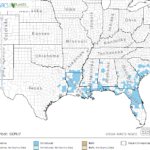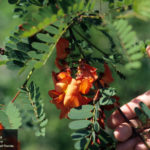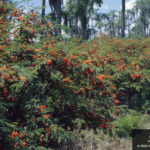Sesbania punicea
Non-Native
USDA, NRCS. 2018. The PLANTS Database (http://plants.usda.gov, 28 March 2018). National Plant Data Team, Greensboro, NC 27401-4901 USA.
What is Rattlebox?
Physical Characteristics
Leaves:
- Alternate
- Compound
- 5-7 inches long
Leaflets:
- 7-16 pairs
- Opposite
- Elliptical shaped
- Up to 1 inch long
Flowers:
- 0.5-1 inch long
- Orange-red in color
- Hang in clusters
Seeds:
- Seed pod rattles when shaken
- 3-4 inches long
- Dark brown in color
- 3-9 seeds per pod
Stem:
- Woody shrub
- Up to 15 feet tall
- Covered in bumps
- Gray-reddish brown in color
Where Does it Grow?
Non-Native
Rattlebox can be found along the edges of rivers and streams.
Is it Invasive?
Rattlebox is non-native to North America and should not be spread. It is an aggressive invader that out-competes the native vegetation for vital resources.
Pros and Cons of Rattlebox
Every part of rattlebox is poisonous, especially the seeds. This plant is non-native to the United States, and tends to disrupt the ecosystem by pushing the native species out of their habitat.
This plant is not native to North America, but has naturalized in much of the United States. While it is not illegal to possess this plant in Texas, it should not be introduced into new water bodies and should be treated with herbicide when present.



